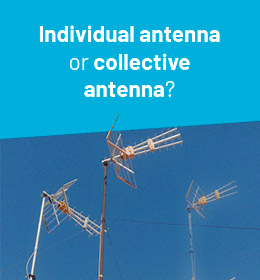When looking to improve signal reception in telecommunication environments, it is common to consider the choice between an individual antenna and a collective antenna. Both have advantages and disadvantages that should be taken into account when making an informed decision. In this article, we will explore in detail the features and benefits of each type of antenna to determine which is the best choice for improving signal reception in different situations.

Contents
Highlights of individual antennas
An individual antenna is an antenna designed to serve a single user or device. It is installed at a specific point and is aimed at providing optimal coverage in that area. Some advantages of individual antennas are:
Direction control:
Direction control is a prominent feature of individual antennas that allows the antenna to be adjusted and pointed in a specific direction for best signal reception. This ability to control the direction of the antenna offers several significant advantages:
Maximizes signal quality: By being able to point directly towards the desired signal source, individual antennas can minimize interference and pick up the signal more clearly. This results in a higher quality of the received signal, which improves the communication and data transmission experience.
Overcoming obstacles: In environments where there are physical obstacles, such as buildings, trees or hills, the directional control of the individual antennas allows avoiding these obstacles by pointing the antenna in an unobstructed direction. This reduces potential interference and improves signal reception in areas where other types of antennas might have difficulty overcoming obstacles.
Minimizes interference: In environments with multiple signal sources or electromagnetic interference, the directional control of individual antennas allows you to specifically target the desired source and avoid picking up unwanted signals. This helps to reduce interference and improve the clarity and stability of the received signal.
Optimizing transmission distance: By controlling the direction of the antenna, the transmission distance can be optimized based on the location of the signal source. By pointing the antenna directly towards the source, higher signal strength can be achieved and the communication range can be extended, especially in areas where the signal may be weak or greater coverage is required.
Customization of signal reception: The direction control allows customization of signal reception according to individual needs. Each user or device can adjust the orientation of their antenna to suit their specific location and improve signal quality in that particular direction. This provides flexibility and allows the connectivity experience to be optimized on an individualized basis.
Higher profit
Individual antennas typically offer higher gain compared to collective antennas. Gain refers to the antenna’s ability to concentrate its radiation energy in a specific direction. With higher gain, the individual antenna can pick up weak signals more efficiently and provide better signal quality. This is especially beneficial in areas with a weak signal or interference, as the individual antenna can amplify and focus the incoming signal.
Installation flexibility:
A key advantage of individual antennas is their installation flexibility. You can place the antenna at a strategic point that optimizes signal reception in the desired area. This allows you to adjust the orientation of the antenna to point directly towards the signal source, resulting in better reception in that specific direction. In addition, individual antennas are typically more compact and easier to install compared to collective antennas, providing greater freedom in choice of location and adaptability to different environments.
However, individual antennas also have some limitations, such as:
Limited coverage:
Although individual antennas offer significant benefits, an important feature to consider is their limited coverage. Due to their focused and oriented design, individual antennas have a specific range and can provide excellent signal reception in a given area. However, their coverage is restricted compared to collective antennas, which are designed to provide a wider signal and cover a larger area. It is important to consider this factor when deciding between an individual antenna and a collective antenna, depending on the signal coverage needs of your specific situation.
Requires individual installation:
Individual antennas require individual installation, which means that each user or device must have its own antenna. This can be more costly and require more effort in terms of installation and maintenance. Each antenna must be correctly installed and properly adjusted to achieve the best signal reception results. However, this individualized installation also offers greater control over the signal quality and allows it to be tailored to the specific needs of each user or device.
Highlights of Collective Antennas
A collective antenna, also known as a community antenna or shared antenna, is used to provide signal coverage to multiple users or devices in a given area. Some advantages of collective antennas are:
Wide coverage: collective antennas have wider coverage compared to individual antennas. They can serve multiple users in a larger area, resulting in better overall coverage.
Lower installation cost:
One of the outstanding advantages of collective antennas is that they generally have a lower installation cost compared to individual antennas. This is because a single collective antenna can provide coverage to multiple users or devices, reducing the need to install and maintain multiple individual antennas. In addition, by requiring a single centralized installation, the costs associated with infrastructure and materials also tend to be lower. This makes collective antennas an attractive option in situations where a wide area needs to be covered on a limited budget.
However, there are also considerations to keep in mind with collective antennas:
Lower individual gain:
A distinguishing feature of collective antennas is that they have lower individual gain compared to individual antennas. Gain refers to the ability of an antenna to amplify and direct the received signal. In the case of collective antennas, the signal is divided among multiple users or devices, resulting in reduced individual gain compared to an individual antenna that focuses exclusively on one point. This means that signal quality may be slightly affected compared to a high-gain individual antenna. However, collective antennas are designed to compensate for this by providing wider coverage and serving multiple users simultaneously.
Less directional control:
In terms of directional control, collective antennas offer lower capacity compared to individual antennas. Since collective antennas are designed to provide coverage to multiple users or devices over a wide area, their focus is directed towards general, omnidirectional coverage. This means that the antenna orientation cannot be adjusted individually to point directly at a specific signal source, as can be done with an individual antenna. However, this omnidirectional approach allows greater flexibility and convenience for users, as it is not necessary to adjust the antenna orientation manually to obtain good signal reception in different directions.
Which offers better connectivity in residential environments?
When it comes to improving connectivity in residential environments, it is important to evaluate the differences between individual antennas and collective antennas to determine which offers better connectivity. The following is a discussion of the relevant aspects to consider:
Coverage and range:
Antenna coverage and range are key factors in residential environments. Individual antennas are designed for a single point of reception and may offer more limited coverage compared to collective antennas. Collective antennas, when shared by multiple users, provide wider and more uniform coverage throughout the residential environment.
Number of users and devices:
Consider the number of users and devices that need to access the signal in the residential environment. If there are multiple simultaneous users and devices, a collective antenna can better manage the traffic load and ensure optimal performance for all. In contrast, individual antennas may have limitations in terms of capacity to handle multiple simultaneous users and devices.
Signal quality:
Signal quality is a crucial factor for good connectivity. Individual antennas typically have higher gain compared to collective antennas, allowing them to pick up weak signals more efficiently. This can result in better signal quality and stronger reception in areas close to the individual antenna. However, in residential environments with wide coverage, collective antennas can provide more uniform signal quality throughout the space.
Cost and installation complexity:
Individual antennas require custom installation and configuration for each user in the residential environment. This involves higher initial cost and complexity compared to collective antennas, which are installed once and shared among multiple users. Collective antennas can be less expensive and less complicated to deploy in residential environments.
Flexibility and scalability:
Individual antennas offer flexibility in terms of location and directional adjustment to optimize signal reception at a specific point. This can be beneficial if there are specific signal sources to be targeted. On the other hand, collective antennas offer a more scalable solution, as they can easily adapt to new users and devices without requiring significant changes to the existing infrastructure.
Advantages and Disadvantages of Individual Antennas
| Advantages | Disadvantages |
|---|---|
| Direction control: Individual antennas allow adjustment of the antenna orientation towards the desired signal source. This provides the ability to point directly at the signal and obtain better reception in that specific direction. | Limited coverage: Due to their design for a single reception point, individual antennas may have limited coverage compared to collective antennas. In areas far from the antenna, reception may be weaker. |
| Higher profit: Individual antennas usually have a higher gain compared to collective antennas. This means that they can pick up weak signals more efficiently and provide better signal quality in areas close to the antenna. | Cost and installation effort: Each user or device that wishes to benefit from an individual antenna must install its own antenna. This implies an additional cost and individual installation effort for each user. |
| Installation flexibility: Individual antennas offer the freedom to choose the most suitable location to install the antenna. This allows you to consider factors such as height, visibility and distance to the signal source, thus optimizing reception quality. |
Advantages and Disadvantages of Collective Antennas
| Advantages | Disadvantages |
|---|---|
| Broad coverage: Collective antennas have the ability to provide wider coverage compared to individual antennas. They can serve multiple users in a larger area, providing better overall coverage. | Lower individual gain: The signal gain of a collective antenna is divided among the users, which can result in a weaker signal compared to an individual antenna in areas close to the antenna. |
| Shared installation cost: By sharing an antenna among several users, the cost of installation and maintenance is divided among them. This can result in significant savings compared to installing individual antennas for each user. | Less steering control: When shared by several users, it is not possible to adjust the direction of a collective antenna to specifically target a desired signal source. This may result in less optimal reception in some directions. |
Factors to consider for a reliable connection
Required coverage:
The required coverage is a crucial factor to consider when choosing between an individual antenna and a collective antenna for a reliable connection. Evaluating the area you need to cover will help you determine which type of antenna is best suited for your needs.
If you are looking to cover a small, specific area, such as an individual home or office, a single antenna may be sufficient. These antennas are designed to provide optimal coverage at a specific point and allow greater control over the direction of the signal. You can adjust the orientation of the antenna to point directly at the desired signal source, ensuring better reception in that specific direction. In this case, an individual antenna is a convenient option, as its focus is on meeting the needs of a single user or device.
However, if you need to cover a wider area, such as an apartment building or residential complex, a collective antenna may be more suitable. These antennas have the ability to provide wider and more uniform coverage, resulting in better signal reception throughout the area. When shared by multiple users, a collective antenna can serve multiple devices simultaneously, making it an efficient choice for environments with a large number of users and devices.
The choice between an individual antenna and a collective antenna depends on the size and characteristics of the area you want to cover. If you are looking for focused and precise coverage in a specific area, an individual antenna is the right choice. On the other hand, if you need broad and uniform coverage over a larger area, a collective antenna is the recommended option.
It is important to carefully evaluate your needs and consider the size of the area to be covered when making an informed decision about which type of antenna is best suited to ensure a reliable connection. Remember that there are also other factors to consider, such as the number of users and devices, direction and gain control, cost and scalability, as well as local regulations and restrictions, which may also influence your final choice.
Number of users and devices:
The number of users and devices that need to access the signal is another critical factor to consider when looking for a reliable connection. The antenna’s ability to efficiently manage the traffic load and ensure optimal performance for all users is critical to a smooth connection experience.
If there is only one user or a limited number of users who need to access the signal, a single antenna may be sufficient. These antennas are designed to serve a single user or device, making them suitable for environments where connectivity demand is low. They provide a direct link between the device and the signal source, which can provide robust performance and satisfactory signal quality for individual users.
However, in environments with many users and devices that need to access the signal simultaneously, a collective antenna is more suitable. These antennas have the ability to efficiently handle a larger traffic load and distribute the signal evenly among users. By sharing an antenna among multiple users, the use of network resources is optimized and equitable performance is ensured for all connected devices.
In addition, a collective antenna can implement efficient traffic management and scheduling techniques to ensure that each user receives a fair share of the available bandwidth. This results in a more stable connection and an improved user experience, especially in situations where there is a high demand for connectivity, such as in office buildings, residential complexes or crowded public spaces.
When considering the number of users and devices that need to access the signal, it is important to evaluate both the present and the future. If there is a possibility of growth or if the number of users is expected to increase over time, a collective antenna offers greater scalability and flexibility to adapt to changing needs.
Direction and gain control:
Direction control and signal gain are key factors to consider when looking for a reliable connection. These elements determine the antenna’s ability to target a specific signal source and pick up weak signals, which directly affects the quality and stability of the connection.
If you need to point directly at a specific signal source or are in an area with weak signals, an individual antenna with directional control and higher signal gain may be the best choice. Individual antennas allow you to adjust the orientation of the antenna to point directly at the desired signal source. This gives you the ability to point the antenna towards a specific transmission tower or access point, resulting in stronger reception and a more stable connection in that particular direction. In addition, the higher signal gain of individual antennas allows them to pick up weak signals more efficiently, which improves signal quality and the connection experience in areas close to the antenna.
On the other hand, if signal direction is not a critical factor and you are looking for widespread coverage over a wider area, a collective antenna may be more suitable. These antennas are designed to provide broad, uniform coverage rather than a specific focus in a particular direction. When shared by multiple users, collective antennas are strategically installed to provide equal coverage throughout the space, ensuring a stable, quality connection for all users. If you do not have the need to point directly at a specific signal source and widespread coverage is more important, a collective antenna is a practical option.
Cost and scalability:
Consider the cost of installing and maintaining antennas. Individual antennas may require custom installation and configuration for each user, which may result in a higher initial cost. On the other hand, a collective antenna can share costs among several users, which can make it more economical. In addition, if there is the possibility of future expansion or adding more users, a collective antenna may be more scalable and flexible compared to individual antennas.
Regulations and restrictions:
When considering factors for a reliable connection, cost and scalability are important aspects to consider. Both individual and collective antennas have different implications in terms of installation and maintenance costs, as well as their ability to adapt to future expansion needs.
Individual antennas typically require customized installation and configuration for each user. This means that each user or device wishing to benefit from an individual antenna must perform its own installation, which can result in additional costs in terms of equipment, materials and professional services. Since each individual antenna is installed independently, initial costs can add up quickly, especially if multiple users or devices are involved.
On the other hand, collective antennas can offer a cost advantage. By sharing an antenna among several users, the cost of installation and maintenance is divided among them. This can result in significant savings compared to installing individual antennas for each user. In addition, maintenance and repair costs can also be shared, which can make maintenance more economical in the long run.
In addition to cost, scalability is another important aspect to consider. If there is the possibility of future expansion or the need to add more users or devices to the network, a collective antenna can be more scalable and flexible. By having a centralized infrastructure, it is easier to add new connections or users without having to perform additional individual installations. This provides greater flexibility to adapt to changes in demand and allows for more efficient network growth.







